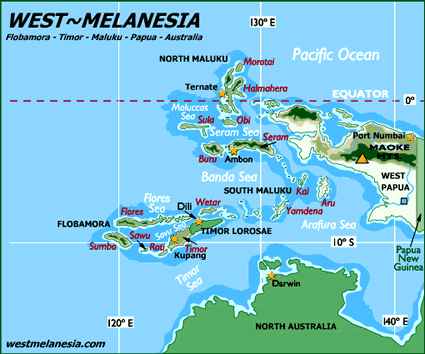The Ujir, also known as the Ujir or inhabitants of Pulau Ujir, are an indigenous Austronesian-Papuan ethnic group native to the remote Aru Islands in Maluku Province, eastern Indonesia, primarily residing on the small, forested island of Ujir off the northwest coast of larger Aru landmasses, amid mangrove-fringed shores and coral reefs in the Arafura Sea. Their name derives from the island itself, a historic maritime hub reflecting their seafaring heritage and linguistic isolate, the Ujir language, spoken by this tight-knit coastal community. As part of the broader Aru cultural mosaic, the Ujir trace origins to ancient Austronesian migrations blending with Papuan settlers around the 13th century, establishing semi-autonomous villages centered on tidal rhythms and inter-island trade networks that exchanged trepang, bird-of-paradise feathers, and spices for ceramics and metals from as far as China and India.
Pre-colonial society thrived as a contact zone on the fringes of the spice route, with oral traditions recounting spirit-guided voyages and clan alliances against raids, while animistic beliefs revered sea guardians and ancestral trees. Islam arrived in the mid-17th century, not solely via traders but through internal dynamics, as Ujir emerged as Aru's Muslim vanguard, compelling conversions or migrations to non-Islamic enclaves like Benjuring; this era fused Koranic ethics with maritime lore, elevating Ujir as a spiritual and commercial nexus.
Dutch colonial incursions from the 17th century onward imposed VOC monopolies on trade, sparking resistance and hybrid economies, while 19th-century missionaries and naturalists like Alfred Russel Wallace documented Ujir's biodiversity and resilience.
Post-independence in 1949, integration into Indonesia brought modernization pressures, including transmigration and resource extraction, yet Ujir communities preserved autonomy through adat governance, navigating globalization while safeguarding their island's role as a living archive of eastern Indonesia's entangled histories.
The Ujir pursue a tidal cadence in their stilted bamboo villages on Pulau Ujir, where lagoon whispers and monsoon swells orchestrate a tapestry of communal ingenuity and seafaring tenacity, harmonizing ancestral crafts with sporadic commerce in Aru's emerald archipelago. Work orbits the ocean's bounty, with men navigating praus to harvest sea cucumbers, trochus shells, and fish via lines and spears in reef shallows, while women mend nets, process catches into dried strips for export, and tend kitchen gardens of cassava, bananas, and sago palms on reclaimed mangrove plots; historical trade in exotic plumes persists in echoes, supplemented by modern ventures like pearl farming and eco-tourism guiding, though scarcity fosters resourceful bartering at Dobo markets. Family dynamics weave extended patrilineal clans into compound homes raised against floods, where elders—clad in sarongs and songket weaves—convene surau councils for dispute mediation, marriages seal alliances through bridewealth of gold or canoes blessed in communal feasts, and child-rearing unfolds in hammock circles with lullabies invoking sea jinn, emphasizing reciprocity and gender complementarity in provisioning the household hearth.
Celebrations ripple with lunar and seasonal pulses, blending Islamic observances like Idul Fitri with boat processions and gamelan-tinged zikir chants under starlit canopies, harvest moons marked by ronggeng dances circling bonfires to honor first catches, and weddings spanning days with henna rituals, mock raids reenacting ancestral voyages, and storytelling epics that bind generations; funerals invoke barzakh transitions with grave-side qasidah recitals and shared vigils floating lanterns seaward.
Food mirrors the reef's generosity in spiced, shared simplicity, staples of ikan bakar—grilled fish slathered in turmeric sambal—paired with sagu lempeng (sago pancakes) and gulai udang (coconut curry prawns), occasional wild boar or dugong roasts for rites symbolizing abundance; beverages of es kelapa muda (young coconut iced with palm sugar) quench gatherings, all savored from nipa-leaf mats to affirm kinship and the island's enduring yield.
Ujirs profess Sunni Islam, a faith woven into their coastal ethos through 17th-century integrations that layered Shafi'i jurisprudence with maritime supplications for safe voyages and bountiful hauls. This tradition permeates routines via five daily salat at waterfront surau, Ramadan fasts broken with communal iftar of spiced broths invoking rahmah, and hajj aspirations framing life as a pilgrim's odyssey across Arafura waves.
Imams and clan heads interlace Koranic recitals with local lore, viewing coral guardians as allusions to divine ayat, while mosques anchor moral compasses for hospitality and zakat distributions, with subtle ancestral harmonies in sea-blessing du'a that echo tawhid's vastness.
There is also a small Evangelical presence in Ujir communities.
Vigilant enforcement of indigenous land titles against corporate land grabs would secure Pulau Ujir's mangroves and reefs, preserving habitats central to cultural narratives and sustainable harvests. Development of bilingual education programs incorporating Ujir oral histories would counteract linguistic erosion from Indonesian dominance, empowering youth to bridge tradition and opportunity. Expansion of community cooperatives for pearl and trochus processing would diversify incomes, mitigating vulnerabilities from fluctuating global markets and climate shifts.
Pray for hundreds of Ujir Muslims to find their way to the cross and the empty grave.
Pray for the Lord to give dreams and visions of the Risen Christ to Ujir family leaders and imams.
Pray for inter-island dialogues with Christian neighbors, nurturing amity through shared Abrahamic values.
Pray for fortified seawalls and reforestation to shield villages from rising tides, sustaining fisheries and sago groves.
Pray for equitable trade pacts in marine resources, fortifying clans against exploitation.
Scripture Prayers for the Ujir in Indonesia.
PeopleGroups.org. "Ujir of Indonesia." https://www.peoplegroups.org/explore/GroupDetails.aspx?peid=22729
Taylor & Francis Online. "Islam in Aru, Indonesia." https://www.tandfonline.com/doi/full/10.1080/13639811.2019.1582895
ResearchGate. "Situs Pulau Ujir di Kepulauan Aru: Kampung Kuno, Islamisasi dan Perdagangan." https://www.researchgate.net/publication/315999851_Situs_Pulau_Ujir_di_Kepulauan_Aru_Kampung_Kuno_Islamisasi_dan_Perdagangan
ScholarHub UI. "The lives of things on Pulau Ujir; Aru's engagement with commercial expansion."
https://scholarhub.ui.ac.id/wacana/vol20/iss3/1/
Taylor & Francis Online. "On the Margins of Colonialism: Contact Zones in the Aru Islands." https://www.tandfonline.com/doi/full/10.1080/10848770.2020.1751965
Linnaeus University. "The Aru Islands: Trade, beliefs and colonial encounters on the fringe of Indonesia."
https://lnu.se/en/research/research-projects/project-the-aru-islands-trade-beliefs-and-colonial-encounters-on-the-fringe-of-indonesia/
Mongabay. "Magnate's visit to Indonesia's untouched Aru Islands revives Indigenous concerns." https://news.mongabay.com/2024/07/magnates-visit-to-indonesias-untouched-aru-islands-revives-indigenous-concerns/
Mongabay. "Saving Aru: The epic battle to save the islands that inspired the theory of evolution."
https://news.mongabay.com/2019/10/saving-aru-the-epic-battle-to-save-the-islands-that-inspired-the-theory-of-evolution/
Rainforest Rescue. "Indigenous people of Indonesia's Aru Islands save one million hectares of forest!"
https://www.rainforest-rescue.org/updates/13988/indigenous-people-of-indonesias-aru-islands-save-one-million-hectares-of-forest
Wikipedia. "Aru Islands Regency."
https://en.wikipedia.org/wiki/Aru_Islands_Regency
Britannica. "Aru Islands."
https://www.britannica.com/place/Aru-Islands
| Profile Source: Joshua Project |











